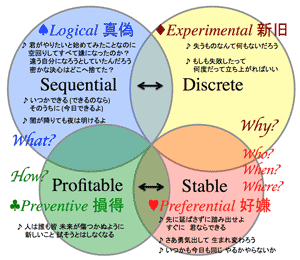Summary |
要約 |
>Top 0. Introduction:
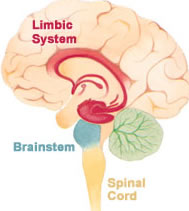 What will you gain from this book?
: What will you gain from this book?
:
- How the brain works.
- What turns you on, and why you do things the way you do them?
- You will see key leadership issues, such as productivity,
motivation, job design, and placement, creativity, and strategic
thinking.
- Limbic system: (source: Wiki)
"The limbic system influences the formation
of memory by integrating emotional states with stored memories
of physical sensations. (limbus = border or edge.)
|
0.
序:
- 本書から何が得られるか?
- 脳の働き
- 何に熱中し、なぜ自分のやり方でやるのか?
- 生産性、動機、仕事の設計、創造性、戦略思考などリーダーシップの基本問題がわかる。
- 辺縁系:
辺縁系は、身体的な感覚の蓄積記憶と共に、情動を統合して、記憶を作ることに関与している。(limbusとは、辺縁の意)
|
>Top 1. The whole brain concept:
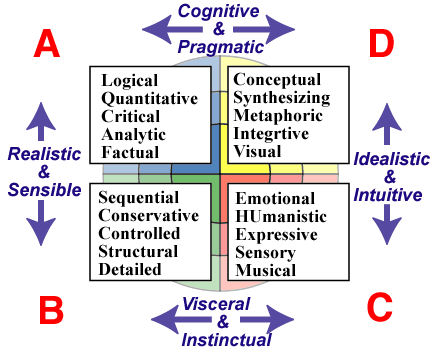 The
Universe of Thinking Styles: The
Universe of Thinking Styles:
- A: Ms. Rational, manager of finance.
- B: Mr. Organized, plant manager
- C: Mrs. Feelings, daycare center
- D: Mr. Experimental, creativity course developer
- Quadrant model of the brain:
Thinking styles can be best described as a coalition of four
different thinking selves.
- A-quadrant Analyzer:
logical thinking, analysis of facts, processing numbers
- B-quadrant Organizer:
planning approaches, organizing facts, detailed review
- C-quadrant Personalizer:
interpersonal, intuitive, expressive
- D-quadrant Visualizer:
imaginative, big picture thinking , conceptualizing
- Physiological roots:
While somewhat primitive compared to the neocortex of the cerebral hemispheres, the limbic
cortex is neural, synaptic, and therefore capable of
thinking in the same way as its cerebral cousin. However, up until
recently, there hasn't been a reliable way of analyzing the mental
processes of the limbic system.
- Psychological tests:
- EEG (Electroencephalographic) data from the brains.
- PET (Positron emission tomography) scanning
- Four thinking styles of the brain:
- The left/right brain dichotomy is too simplistic and incomplete
to serve as a model.
- Sperry's left brain/right brain theory and MacLean's triune
brain theory are integrated into a new comprehensive model.
- The natural phenomenon of dominance between paired structures
of the body applies equally to the brain.
- Both nature and nurture:
- We are a product of both nature and nurture. And it it the nurture
aspect that predominates in who we are and who we can become.
- We have already done this with our right hand or left hand,
and after a few million physical movements based on that preference,
we have developed a lifetime of handedness preference and skill.
- We have developed some of our mental dominance into such strong
preferences: We have become very good at language; or we have
developed impressive math skills; or we are exceedingly organized;
or we can accurately sense that feelings of others; or we are
always coming up with new ideas. these early competencies arising
out of preferences that grew out of dominance characteristics
can lead to entire mental processing families of development.
- Everyone has a least preferred quadrant:
- We as individuals are a coalition of four different selves,
we prefer to use one or more of those selves compared to the others.
- Since we are living in a composite whole brain world, and the
reality of any multifunctional group is the diversity of its thinking
and therefore its perceptions and language, it is essential from
communication standpoint to increase our tolerance of and understanding
of what people are saying who are different from us.
- Same-thinking-style competitiveness:
- What is happening here is that while the thinking styles are
normally very similar, there are some minor differences in preference
that could be just enough to give person #1 a slightly different
perception of a given situation compared to person #2. This
somewhat different perception could lead to "We both have
pretty much the same understanding, but my way is better than
your way."
- It is not my purpose to suggest that competition in thinking
styles is bad. In fact, competitive approaches can lead to better
decisions and better solutions. My purpose is to suggest
that there are consequences to pairing people with similar profiles.
Most people would assume that, since their thinking styles are
so similar, they will be entirely compatible in a team situation.
I'm suggesting that assumption of compatibility might be premature
and that similar but not precisely the same thinking style could
lead to vigorous competition.
- Adam and Eve in the workplace:
- The pattern created by the 5,000 businesspeople was extraordinarily
well balanced except in the A and C quadrants. There were
a lot more baseball caps (men) in the A quadrant and a lot more
berets (women) in the C quadrant.
- Generally speaking, most of the baseball caps would have wives
from a different quadrant than theirs and, similarly, most of
the berets would have husbands from a different quadrant than
theirs, thus confirming that opposites attract. In stark contrast,
most of the single people, either male or female, who, while unmarried,
were living with someone, would have a "most significant
other " typically in the same quadrant that they occupy.
- We have the opportunity to observe relatively homogeneous teams,
both in thinking style and gender, as they undertake creative
workshop assignments. The homogeneous teams of either gender tend
to reach early consensus and settle too quickly on what prove
to be mediocre conclusions. In comparison, gender-balanced,
heterogeneous teams not only consume all the time allowed, but
also ask for additional time and almost invariably produce the
highest, most imaginative, creative results.
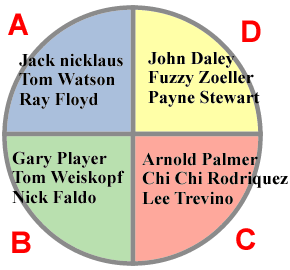 Different
quadrant styles of golfers: Different
quadrant styles of golfers:
- Lee Trevino will be cracking jokes with the gallery and then
typically walk up to his ball, take one practice swing and fire
way.
- Gary Player will be meticulous in his preparation, excruciatingly
slow in finding a comfortable position, taking numerous practice
swings, and then finally executing the actual shot.
- Jack Nicklaus consume several minutes in preparation before
addressing the ball for the actual shot, and when the ball misses
his intended target by as much as ten feet, he will become visibly
upset and take a few more practice swings to correct the error
of his ways.
- Fuzzy Zoeller, whistling a happy tune, jauntily approach his
ball and within the span of a few seconds, hit his ball and
continue to whistle his way to the next shot without a sign
of remorse over landing in a trap.
- These professional golfers are all playing the same game but
their approach is differentiated by their mental preferences.
|
1.
全脳のコンセプト:
- <左図> 思考スタイルの宇宙:
- A: 理性氏
- B: 組織氏
- C: 感覚氏
- D: 実験氏
- 大脳の4象限モデル:
思考スタイルは4つの異なる4分身の連合として表現できる。
- A象限: 分析する人
論理思考、事実の分析、数値処理
- B象限: 組織する人
取り組みの計画、事実の体系化、詳細な検討
- C象限: 個人重視をする人
対人関係、直感的、表現力に富む
- D象限: 視角化する人
想像力、大局観、概念化
- 生理学的な起源:
辺縁系皮質は、大脳半球の新皮質に比べて、やや原始的であるが、神経系でシナプスを持ち、従兄弟にあたる大脳新皮質と同じよう考えることができる。但し、ごく最近まで、辺縁系システムの思考機能については信頼できる分析方法がなかった。
- 生理学的テスト:
- 脳波計 (EEG)
- 陽電子断層撮影法 (PET)
- 大脳の4つの思考スタイル:
- 左脳・右脳の二分論はモデルとして単純すぎて不完全
- スペリーの左脳・右脳理論、マクリーンの三位一体脳理論を統合し、新たな包括モデルとした。
- 身体の一対構造間の優位に関する自然現象は、脳にも同じように適用される。
- 我々先天性と後天性の賜物である。
我々はこのことを利き腕の経験している。右手や左手を無意識の内に優先的に何万回も使った結果、利き腕の優先とスキルは生涯変わらぬものになった。
- 我々は強い優先の中に心理的な優位を発達させ、特定の思考方式における能力を獲得した。例えば、語学が強い、数学的なスキルがある、卓越した系統化の能力がある、他人の勘定を正確に読み取る、いつも新しいアイデアを思いつくなどである。
- 誰でも劣後象限をもっている:
- 我々は個人として4つの異なる自分の連合体なので、1つ、2つを他より多く使いたくなる
- 我々は、全体としてはすべてのタイプがいる全能の世界に住んでおり、また様々な機能グループが存在しているので、彼らの考え方、見方、言葉は多様である。それゆえ自分と異なる人々に対する寛容と理解力を高めることは、コミュニケーションの観点から非常に重要となる。
- 同じ思考スタイルの競合:
- 思考スタイルが表面的に非常に似ていても、優先度のわずかな差が、ある状況についての受け止め方に食い違いを生じる。従って「我々の理解の仕方は基本的は同じだが、私のやり方の方があたなのやり方よりも良い」という考えに行き着く。
- ここでは、思考スタイルの競合が悪いと言うためではない。事実、競合的アプローチはより良い決断や解決をもたらすこともある。ここで指摘したいことは、プロフィールの似たもの同士を組ませる結果は様々であることを認識する必要がある。多くの人は、彼らの思考スタイルが似ているからチームとして両立できると決め込む。しかし、両立可能とするのは早計であり、よく似てはいるが全く同じでない思考スタイルの場合、時には激しい競争になる点を指摘したい。
- 職場のアダムとイブ:
- 5,000人の職業人が創り出すパターンは、AとC象限を以外では、非常に良くバランスがとれている。A象限には野球帽 (男性)と多く、C象限にはベレー帽
(女性)が多い。
- 一般的は、野球帽の大半の人は自分の象限とは違った象限の妻をもち、同様に、ベレー帽 (女性) の大半は違った象限の夫をもつ。つまり、反対のタイプ同士が引き合うという事実が確認される。また対照的に、独身者の大半は男女を問わず、未婚で同居している場合、最も大事な他人は同じ象限にいる。
- 思考スタイルおよび男女が同質のチームで、創造性開発ワークショップを実施してみると、男女どちらのチームもすぐにコンセンサスに達し、平凡な結論で満足してしまう傾向が強い。これと対照的に、男女のほぼ同数の異質なチームは、予定時間をすべて使ってなお追加時間を要求し、どのチームも高いレベルで想像力に満ちた創意に富んだ結論を出した。
- ゴルファーの異なる4象限スタイル:
- リー・トレビノはギャラリーと冗談を言いながらボールに近づくと、1回素振りしただけで思い切ってショットする。
- ゲーリー・プレーヤーは細心の注意を払って慎重に足場を確かめて何度も素振りを行った後で、ようやく本番のショットする。
- ジャック・ニクラウスは、ボールにアドレスするまでに数分間を費やすことがあり、打ったボールが狙った目標から10フィートでも外れると、見るからにイライラし、ミスを直すためにさらに2、3回素振りする。
- ファジー・ゼラーは、幸せそうに口笛を吹き、さっそうとボールに近づき、2、3秒の間にボールを打つ。また口笛を吹いて次のショットに向かい、ボールが罠にはまっていても全然気にしない。
- これらのプロゴルファーは、皆同じゲームをしているが、アプローチは彼らの思考優先によって大いに異なっている。
|
>Top 2. Turn-On work indicator map; corresponding
to each quadrant.
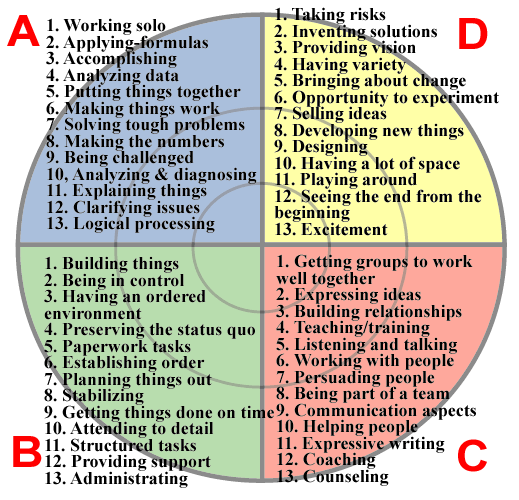
|
2. 4象限毎に熱中する仕事マップ:
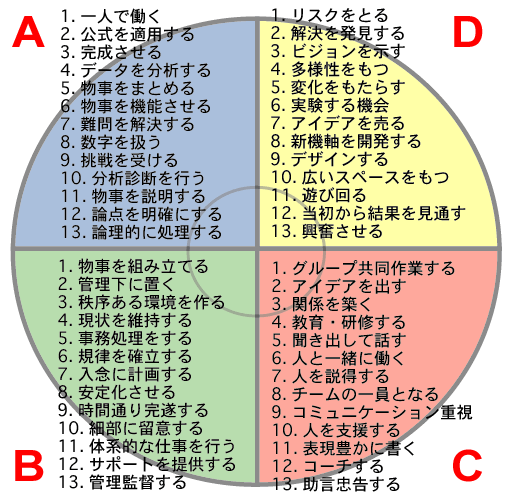
|
>Top 3. Male/Female differences:
- Gender norms reflected in management style norms. Men are more
A/B; women prefer C and D quadrants.
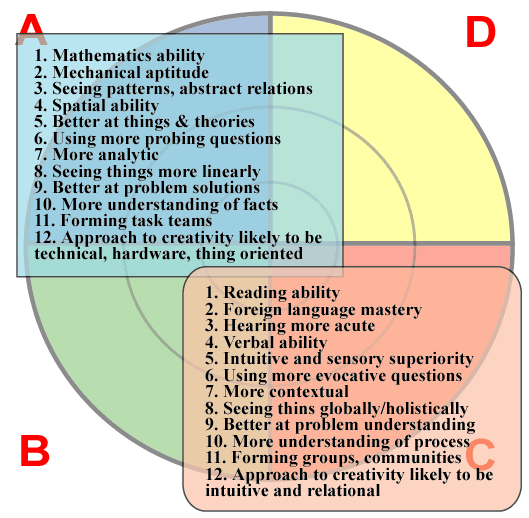
- The left mode A/B style has a strong alignment with male-oriented
preferences (logical, analytic, rational, structured, and organized)
- The right mode C/D style has a strong alignment with female-oriented
preferences (interpersonal, emotional, expressive, informal, and
open). These two styles show the same dominance characteristics
that exit in Western culture.
- A/D quadrant style combines technical and experimental thinking
and is therefore the primary style for scientist, inventors, and
research and development organizations.
- B/C quadrant style is strongly service-oriented and considers
employees, customers, and the community to be high-priority stakeholders.
This style tends to favor the status quo and doing what's right
for the company and the individual.
|
3.
男性・女性の差異:
- マネジメント・スタイルでは、男性はよりA/B、女性はC/D象限を優先する。
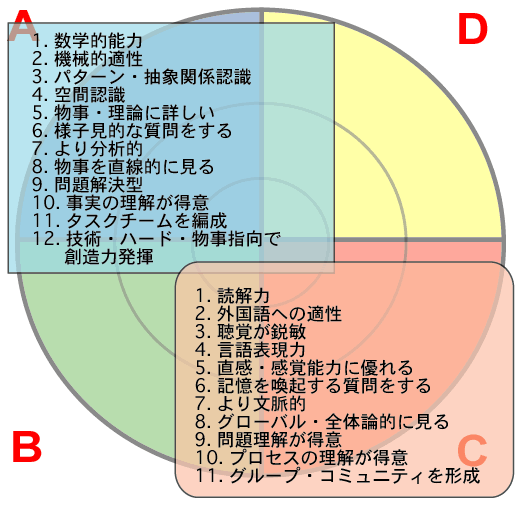
- A+Bの左脳スタイルは男性に多い思考優先(論理的、分析的、合理的、階層的、組織的)と相関関係がある。
- C+Dの右脳スタイルは女性に多い思考優先(人間関係重視、情緒的、表現豊か、非形式的、開放的)と相関関係がある。これらの2つのスタイルは西欧文化に存在する支配の特徴を示している。
- A+D象限のスタイルは、技術的思考と実験的志向を併せ持つので、科学者、発明家、研究機関の基本スタイルである。
- B+C象限のスタイルは、サービス思考が強く、社員、顧客、地域社会を高順位の利害関係者であると考える。このスタイルは現状維持を好み、会社と個人にとって正しいことを実行しようとする。
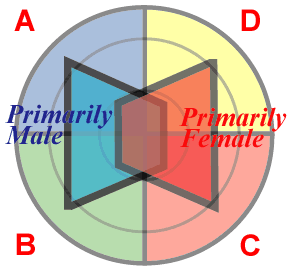 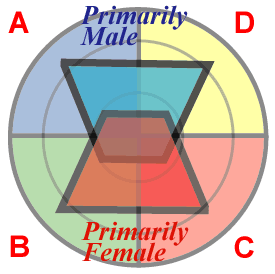
|
>Top 4.
The whole brain organization:
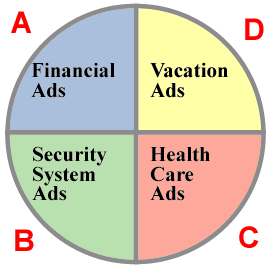 Whole
brain marketing: Whole
brain marketing:
- Ads that appeal to a particular quadrant preference:
- Ads dealing with financial investments are almost always black
and white, very straightforward, crowded with numbers and percentages.
- Ads for vacations are dramatically different. These are almost
always four-color, with exotic scenes provocatively displayed
and often curvaceous females or hot air balloons, or sunsets
in the background.
- Family health care ads are often soft-focus photos of caring
parents and smiling children, designed to pull at our heartstrings.
- Automobile ads, particularly those in automobile magazines,
are often multiple-page foldouts in full color, ranging across
all four quadrants in order to appeal to every potential
facet of a prospective buyer's fantasies.
-
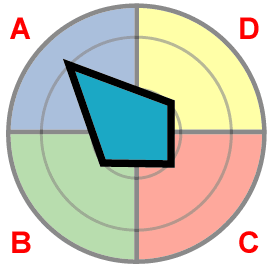 A-quadrant
style is typically authoritative, directive, and all-business. A-quadrant
style is typically authoritative, directive, and all-business.
- A-quadrant style if often characterized as authoritarian
or directive or strictly business. But it doesn't have to
be that way. The obvious virtues of A-quadrant preferences
and competencies can be packaged in other combinations, particularly
when there are no significant turn-offs that foreclose the
active contributions from the other quadrants.
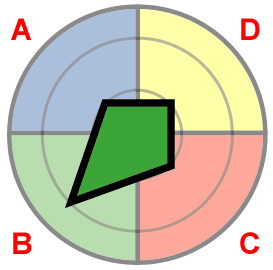 B-quadrant
style is typically traditional, conservative, and risk
avoiding: B-quadrant
style is typically traditional, conservative, and risk
avoiding:
- This is an area where work needs to be performed on the basis
of documented procedures and strict schedules. It is in this function
that programs like zero defects and total quality management are
rigorously implemented.
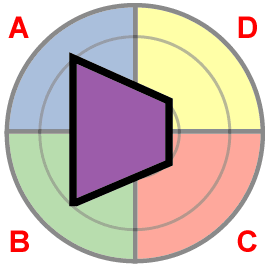 A
& B-quadrant management style is practical and realistic: A
& B-quadrant management style is practical and realistic:
- Managers with this combination of preferences often have supplemented
their competencies with an MBA degree. This represents an overlay
of financial measurement on top of other functional competencies
such as engineering or manufacturing. This increase the relative
hardness of the resulting style.
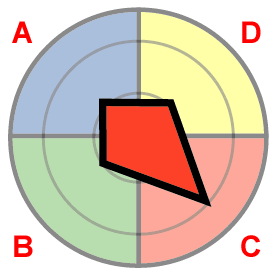 C-quadrant
style is personable, interactive, and intuitive. C-quadrant
style is personable, interactive, and intuitive.
- It is a style that considers the human resource as the primary
asset of the business. They are also advocates of employee development,
on-site training, and taking into account the design and safety
characteristics of the employee working facilities.
- They are often tolerated by A and B-oriented senior managers
as a necessary part of the business, but certainly not where command
decisions are made.
 D-quadrant
style is holistic, risk-oriented, adventurous, and entrepreneurial. D-quadrant
style is holistic, risk-oriented, adventurous, and entrepreneurial.
- This style is often in direct opposition to the prevailing culture.
- This style is wonderful for individuals who are independent
and thrive under a system which trusts they will put in the time
necessary to get the work done.
- Fund and creative thinking are legitimized. This style considers
outside the box thinking and work sprit to be as important as
technical excellence.
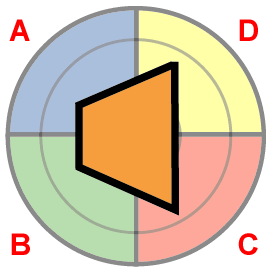 C
& D-quadrant style is open-minded, intuitive, and flexible. C
& D-quadrant style is open-minded, intuitive, and flexible.
- C/D right mode style is people-oriented, open-minded, and inclined
to be idealistic.
- A
& D-quadrant style:
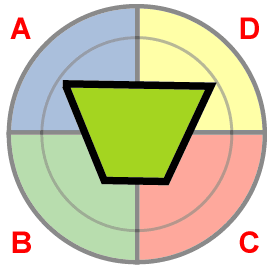 the cerebral style combines preferences
for technical and experimental thinking. the cerebral style combines preferences
for technical and experimental thinking.
- This is the primary style for scientists, inventors, and research
and development organizations.
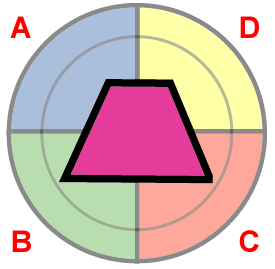 B
& C-quadrant style: The limbic style combines the stability
of tradition with a caring responsiveness. B
& C-quadrant style: The limbic style combines the stability
of tradition with a caring responsiveness.
- This style tends to favor the status quo and doing what's right
for the company and the individual. It has a strong production
orientation, but not at the expense of the people involved. A
strong loyalty often accompanies the limbic style.
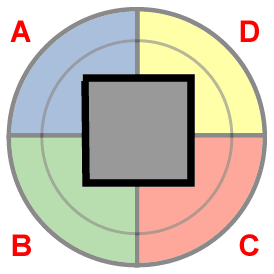 A+B+C+D
quadrant style: The multidominant style enables a manager
to respond to a diverse set of business issues. A+B+C+D
quadrant style: The multidominant style enables a manager
to respond to a diverse set of business issues.
- To be an effective practitioner of the multidominant style requires
an opportunity to apply it frequently enough that an appropriate
array of competencies can be developed. Managerial and leadership
positions that have a high frequency of multidominant opportunity
include plant manager, project manager, multifunction team leader,
executive secretary, and of course, chief executive officer.
|
4.
全脳的な組織:
- 全脳的なマーケティング:
- 金融投資を扱う広告は、ほとんど白黒で、非常に率直に、数字や比率で埋め尽くされている。
- 休暇旅行の広告は、まったく異なる。常に4色刷で、エキゾチックなシーンや曲線美の女性や熱気球などが夕焼けを背景にしてある。
- 家族の健康の宣伝は、しばしばソフトフォーカスの写真の中に世話をする両親と笑顔の子供達を載せて我々の心の琴線を揺さぶろうとする。
- 自動車広告、とくに専門誌に掲載されたものは、何ページも多色刷り折り込みに4象限全てを網羅して、見込み客の夢にあらゆる面からアピールしようとする。
- A象限スタイルは、典型的な権威主義、命令調、かつビジネス・ライク:
- A象限スタイルは、権威主義者とか命令調とかビジネス一辺倒と性格づけられる。しかし必ずしもそうとは限らない。A象限の思考優先と適性能力は紛れもない美徳であり、別の象限との組み合わせによって一層の効果を上げることができる。特に他象限からの積極貢献を排除するようなやる気のなさがなければ、素晴らしいものになる。
- B象限のスタイルは、典型的に伝統を重んじ、保守的で、リスクを避ける傾向がある。
- この部門の仕事は手続きと厳格な日程に従わなければならない。この機能こそ欠陥ゼロ運動とかTQMが厳密に実行される分野である。
- A-B象限のマネジメント・スタイルは実務的で現実的である。
- この組み合わせをもつマネジャはMBAで能力を補うこともある。これはエンジニアリングや生産技術といった職能の上に財務的な能力を重ねることで、結果として相対的に硬派スタイルが強まる。
- C象限スタイルは親しみやすく、相互交流を求め直感的である。
- このスタイルは、人材を企業の第一の資産と考える。彼らはまた、社員啓発、現場教育、さらには職場のデザインや安全性などを主張する。
- 彼らはAや B指向の上級幹部から業務に必要な一部として看過されていることが多いが、それとても指揮命令を決断する場面はない。
- D象限スタイルは全体論的で、リスクを恐れず、冒険心に富み、起業家精神をもつ。
- このスタイルは現行カルチャーに真正面からぶつかることが多い。
- このスタイルは独立して働き、完成に必要な自由時間を許すシステムの下で成長する個人にとっては本当に素晴らしいものである。
- 遊び心と創造的指向とは同じ血筋である。このスタイルは枠外の指向・精神を尊重することを技術優位と同等に扱う。
- C+D象限スタイルは、開放的で直感的かつ柔軟である。
- C+D右脳モード・スタイルは人を気遣い、心が開いており、理想主義的な傾向がある。
- A+D象限スタイル:大脳新皮質スタイルは技術的思考と実験的思考を組み合わせた優先をもつ。
- B+C象限スタイル:辺縁系スタイルは伝統の安定性と注意深い反応とを結びつける。
- このスタイルは現状維持を好み、会社と個人にとって正しいことを実行しようとする。また、強い生産重視思考を示すが関係者の犠牲は好まない。強い忠誠心もしばしば辺縁系スタイルから生まれる。
- A+B+C+D象限スタイル:多象限スタイルのマネジャはビジネスにおける多様な問題に対応できる。
- 多重優勢スタイルの効果的な実行者となるには、それにふさわしい能力を開発できるよう、数多くの機会が必要である。そのような数多くの機械に恵まれたマネジャ、リーダの職位としては、工場長、プロジェクト・マネジャ、多機能チームリーダ、役員秘書、そしてもちろんCEOがある。
|
>Top 5. Communication:
- Communication between people:
- The most difficult end of the communication continuum is where
opposing quadrants are involved in the transaction, such as
the B and D quadrants and the A and C quadrants. Administrators
(B) and art directors (D) in an advertising agency, and financial
managers (A) and employee counselors (C) are such pairs.
- "Men are from mars and Women are from Venus" syndrome.
- A useful tool to insure a whole brain communication is to
apply the four-quadrant communication model to the significant
points of the intended message.
- How the brain communicates:
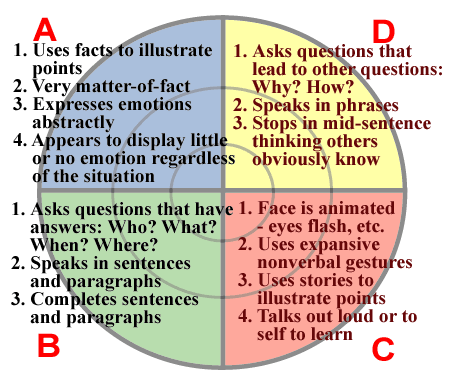
- Increased awareness of these differences aides the communication
process by enabling people to say more precisely what they mean
and to listen more purposefully to what they hear. Improving communications
does more than just relieve personal frustration. When the whole
organization improves, bottom-line results must also improve.
|
5.
コミュニケーション:
- 人々の間のコミュニケーション:
- コミュニケーションが最も困難なのは対角線上の両象限、BとD、あるいはAとCのような場合である。例えば、広告代理店の役員(B)とアート・ディレクタ
(C)、あるいは財務部長 (A)と人事カウンセラー (C)のような場合である。
- 「男は火星から、女は金星から」シンドローム
- 意図するメッセージが重要な場合は、4象限すべての相手に適用できるように全脳コミュニケーションを準備しておくことが役立つ。
- 脳はどのようにコミュニケーションするか
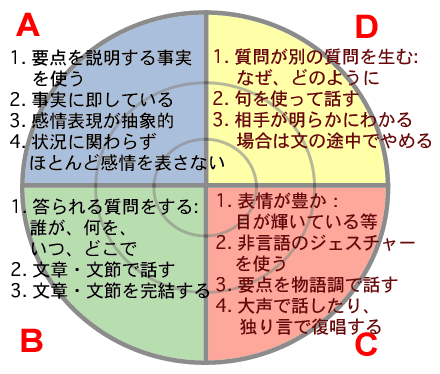
- 各象限のコミュニケーション方法の違いに気付けば、もっと性格に意図する所を話し、またもっと目的意識をもって聞くことができるようになろう。コミュニケーションの改善は単に個人のいらだち解消以上の意味がある。それを組織的に改善すれば、最終結果も改善することになる。
|
>Top Brain
dominance impact on communication between people:
(Left) less difficult --- (Right more difficult):
Same-quadrant - Compatible-quadrant - Contrasting-quadrant
- Cross-quadrant communication:
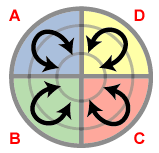 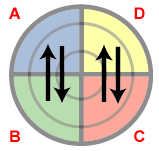 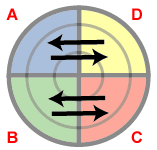 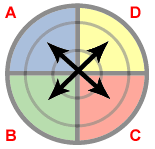
|
>Top 6. Brain training
and development:
- The whole brain teaching and learning model
points out styles for each quadrant and left, right, upper, and
lower modes as well.
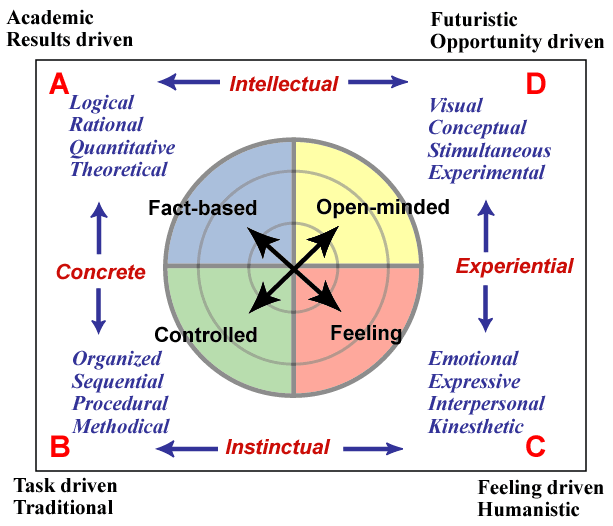
- Pro forma profiles of key leadership issues:
- Annual Report, Mission Statement, Vision Statement, and Corporate
Values.
- These documents establish the purpose and direction of the
business and must represent the thinking of the leadership of
the business, and specifically of the CEO.
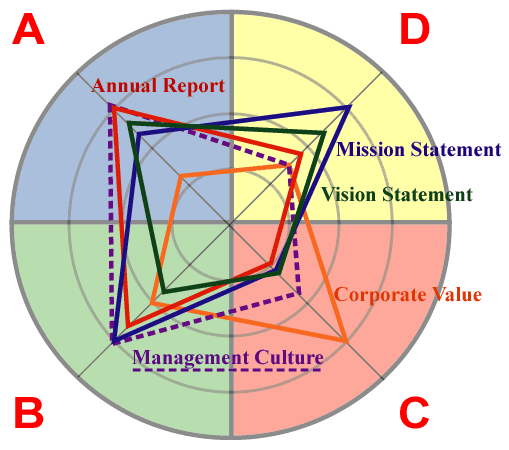
- CEO and leadership:
Looking more closely at the alignment issue, it is likely to be
the case that different functions of the business are at different
levels or degrees of alignment. (For example, the engineering function
may be in stronger alignment than the manufacturing function, etc.)
- One of the roles of the CEO is to diagnose these alignment issues
and do something about them. There are two sides of the equation;
the vision, mission, and goals of the organization on one hand,
and the orientation of the human asset on the other. The CEO needs
to be in a position to affect both.
|
6.
大脳の訓練と発達:
- <左図> 全脳的教育・学習モデル:4象限、上下、左右モードのスタイルを図示
- リーダーシップに関わる重要文書:
- 年度報告書、ミッション声明、ビジョン声明、価値基準
- これらの文書は企業の目的や方針を示しており、企業におけるリーダーシップの考え方、特に、CEOの考え方を表すものでなければならない。
- CEOとリーダーシップ:
これら報告書の整合性の問題を詳しく見ると、それは様々なレベルでのビジネス上の機能の違いの課題を反映しているように見える (例えば、エンジニアリングの機能は生産の機能より強いなど)
- これらレベルCEOの役割の一つは、このような意識と行動の整合性の課題を分析すること、それに関して何か実行することである。それは数式の両辺のようなものである。一方はビジョン、ミッション、組織の目標であり、他方は人的資源の配置の方針である。CEOはその両方に影響力を行使できる立場にある。
|
>Top 7. CEOs around the
world:
- Leadership behaviors and styles differ for CEOs working in European,
Asian-Pacific, and North American countries.
- A recent study of 697 male CEOs and 76 female CEOs from many
countries reveals a surprising consensus of thinking styles,
work preferences, and likely competencies.
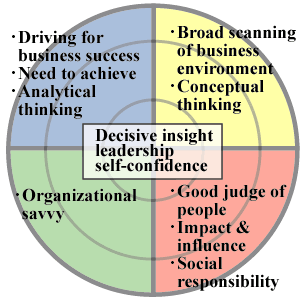 CEOs'
universal traits categorized in the whole brain model: CEOs'
universal traits categorized in the whole brain model:- The study was based on 51 CEOs of top performing corporations
in 14 countries. The best CEOs adapt their behavior to the region
or country where they operate, all of them share universal competencies
that transcend national boundaries. The competencies fall into three
distinct clusters:
- Sharpening the focus:
broad scanning ability, analytical and conceptual thinking, decisive
insight.
- Building commitment:
organizational savvy, good judgment of people, leadership, impact,
and influence.
- Driving for success:
a need to achieve, self-confidence, and social responsibility
- North American vs. Asian-Pacific CEO traits:
- In US culture, successful CEOs demonstrate high levels of
competency known as personal objectivity.
- Far Eastern culture, successful CEOs excel in competencies
known as developing mutual respect and relationship building.
- European vs. North American CEO traits:
-
Many European CEOs tended to heavily emphasize
the development of detailed plans that are clearly communicated
to subordinates. (rational planning)
- Europe: Cultures, & Consequences:
- Germany is like a well-oiled machine, that of France is like
a pyramid, and that of England is similar to a village market.
|
7.
世界のCEOたち:
- リーダーシップの行動やスタイルは、欧州、アジア太平洋、北米のCEOではそれぞれ異なる。
- 各国のCEO男性697名と女性76名に関する研究では、思考スタイル、仕事の優先、必要な力においても驚くべき共通点があることが判明した。
- <左図> CEOの普遍的特性:
- 14ヶ国のトップ企業のCEO51人についての調査。CEOは自らの行動をその国や地域に適応させながら、一方で認知の文化に沿って調整し、国境を越えて適用する普遍的な能力をもっている。
- 明確な焦点:
広範な探索能力、分析的で概念的な思考、明確な洞察力
- 公約の確立:
組織作りノウハウ、人物、指導力、インパクト、影響について適切な判断
- 成功への意欲:
目標達成要求、自信、社会的責務
- 北米対アジア太平洋地域のCEOの特性:
- 米国文化においては、成功したCEOは、個人的客観性として知られる高いレベルの能力をもっている。
- 極東地域文化で成功したCEOは、総合信頼関係の強化、および人間関係の構築という能力に優れている。
- 欧州対北米のCEOの特性:
- 欧州のCEOの傾向として、詳細計画の立案と部下への明治を強調しすぎる面がある。 (合理的計画立案)
- 欧州:文化・社会的重要性:
- 独のビジネス文化は、十分に潤滑油のきいた機械、仏はピラミッドのようであり、英国は村の市場に似ている。
|
- >Top North American,
Asian-Pacific CEO traits: (Left)
- European vs. North American CEO
traits: (Center)
- German-French-English CEOs: (Right)
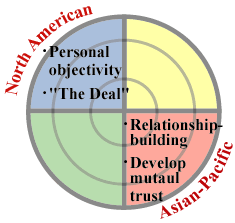 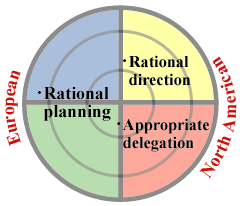 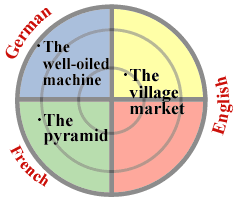
|
>Top 8. The brain is
the source of creativity:
- Creative and innovative thinking work best when the brain is up
to the challenge of increased synaptic activity. Whether you
are feeling sharp or dull at any given moment can be due to the
chemistry in your head.
- Neurotransmitters are the chemical agents that cause synapses
to take place, which in turn produce electrical potentials,
which together with the chemical reactions, power the brain
in its thinking processes.
- Creating process includes:
- Interest: is a general state of alert consideration of a problem
situation. The brain state is beta.
- Preparation: for applying the creative process to a specific
problem situation involves beta at the higher frequencies; more
intense, more purposeful, more applied.
- Incubation: of a problem situation following preparation takes
place in alpha with the lower frequency, high amplitude brain
waves producing the best results of contemplation.
- Illumination: which is often described as the AHA! stage of
the process, takes place in theta. This is the stage where the
potential solution presents itself in the form of an idea.
- Verification: returns the mental process back to beta, and
sometimes occurs at 2:00 am, or in the shower, or while commuting
to work. This is the stage when an alert evaluation of the potential
solution is considered in relationship to the original problem.
This is generally high frequency beta.
- Application: is the final stage of the process, and continues
as an aroused beta level activity.
-
>Top Our
four different selves:
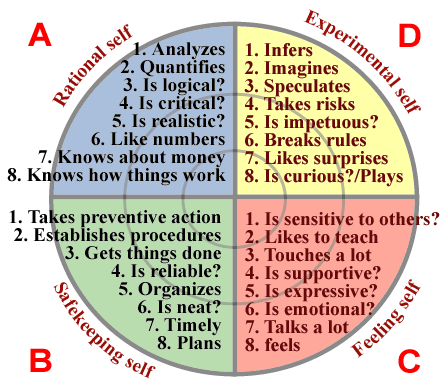
- The diversity within an individual provides the basis for synergy.
A rational idea juxtaposed to an intuitive thought can produce a
new idea through synergistic interaction. When more than one person
is involved, the diversity of mental preferences can significantly
enhance both persons' creative potential.
- It isn't as if a homogeneous team can't come up with a creative
solution. The fundamental problem is that homogeneity leads to quick
consensus.
- In a direct comparison of homogeneous solutions with heterogeneous
ones, the quality of creative team output is clearly in favor of
the heterogeneous teams.
|
8.
大脳は創造力の源:
- 創造的で革新的思考は、脳がシナプス活動の増大に直面することに最もよく働く。ある瞬間に頭が冴えているか鈍くなっているかは、頭の中の化学反応次第である。
- 神経伝達物質はシナプスを刺激する化学物質であり、電位差を生じることで、化学反応を相まって、脳の思考プロセスを活性化させる。
- 創造的プロセス:
- 興味:ある問題状況を注意深く見守る一般的な状態で、脳波はβ波である。
- 準備:創造的プロセスを特定の問題状況に適用する準備段階では、高い周波数のβ波が現れ、より強く、より目的指向で、より応用的となる。
- 培養:準備に引き続く問題情報の培養段階ではより低周波数で大きな振幅のα波が発生し、最良の瞑想状態をもたらす。
- 閃き:プロセス中のAHA!としての閃きの段階は、θ波が生じて起こる。これは潜在的な解決策がアイデアの形になって現れる段階である。
- 検証:知的プロセスをβ波の状態に戻し、時々午前2時に、またはシャワーを浴びているとき、あるいは通勤途中に起こる。これは可能な解決策を本来の問題との関係で評価する段階で、一般的に高い周波数のβ波である。
- 運用:プロセスの最後の段階であり、高揚したβ波レベルの活動が継続する。
- 異なる我々の4分身:
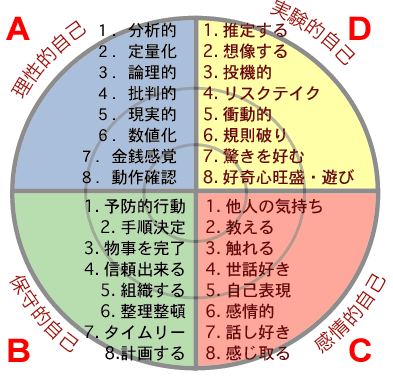
- 個人内部の多様性が相乗効果の基盤となる。論理的なアイデアと直感的指向が並列することで、相乗効果を通じて、新たなアイデアを生み出すことができる。二人以上が関与すれば、思考パターンの多様性が両者の創造的潜在能力を大きく高めることができる。
- 同質のチームが創造的解決策を出せないという訳ではないが、問題は、同質性が拙速なコンセンサスに到達しやすい点にある。
- 同質と異質の場合の解決策を比較すると、創造的なチーム提案の質は明らかに異質チームの方が優れている。
|
>Top Creative
process correlation with quadrant model:
- 創造的プロセス - 4象限モデルとの関連: 興味→準備→培養→閃き→検証→適用
 |
>Top 9. Nature or nurture?:
- Can people change? Yes. Most of us are largely a result of what's
happened to us. About 70% of who we are is the result of nurture
rather than nature.
- Most of us have about a 70% chance of changing if the conditions
are right.
|
9. 先天性か後天性か:
- 人々は変わることができるか? 答えはイエス。我々の大部分は自分に起こったことの結果として存在している。人格の70%は生まれつきではなく、教育による。
- 我々の多くは、条件さえ整っていれば、70%まで変わることができるという訳である。
|




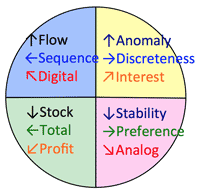
 What will you gain from this book?
:
What will you gain from this book?
:
 The
Universe of Thinking Styles:
The
Universe of Thinking Styles:
 Different
quadrant styles of golfers:
Different
quadrant styles of golfers:






 Whole
brain marketing:
Whole
brain marketing:
 A-quadrant
style is typically authoritative, directive, and all-business.
A-quadrant
style is typically authoritative, directive, and all-business.
 B-quadrant
style is typically traditional, conservative, and risk
avoiding:
B-quadrant
style is typically traditional, conservative, and risk
avoiding: A
& B-quadrant management style is practical and realistic:
A
& B-quadrant management style is practical and realistic: C-quadrant
style is personable, interactive, and intuitive.
C-quadrant
style is personable, interactive, and intuitive. D-quadrant
style is holistic, risk-oriented, adventurous, and entrepreneurial.
D-quadrant
style is holistic, risk-oriented, adventurous, and entrepreneurial. C
& D-quadrant style is open-minded, intuitive, and flexible.
C
& D-quadrant style is open-minded, intuitive, and flexible. the cerebral style combines preferences
for technical and experimental thinking.
the cerebral style combines preferences
for technical and experimental thinking. B
& C-quadrant style: The limbic style combines the stability
of tradition with a caring responsiveness.
B
& C-quadrant style: The limbic style combines the stability
of tradition with a caring responsiveness. A+B+C+D
quadrant style: The multidominant style enables a manager
to respond to a diverse set of business issues.
A+B+C+D
quadrant style: The multidominant style enables a manager
to respond to a diverse set of business issues.







 CEOs'
universal traits categorized in the whole brain model:
CEOs'
universal traits categorized in the whole brain model:



